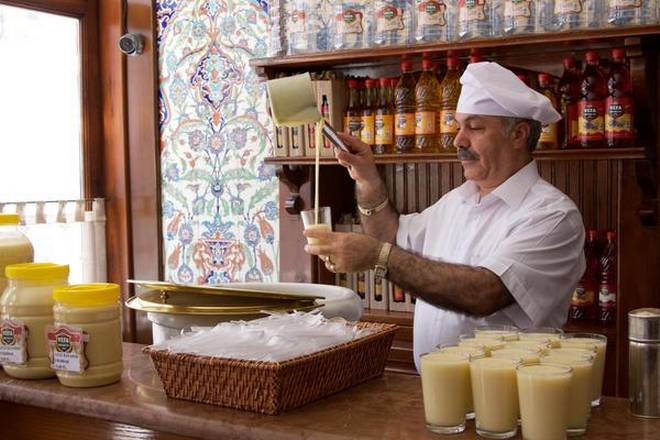The feeling was perfectly captured by Orhan Pamuk in his novel, A Strangeness in My Mind
The setting sun casts a golden glow over the otherwise nondescript street in the residential neighbourhood of Vefa, Istanbul. Not far from Sultanahmet, famous for its numerous historic attractions including the Blue Mosque and Hagia Sophia, Vefa is quieter and calmer. During Ottoman times, this quarter was home to scholars and aristocrats.
Stepping into Vefa Bozacisi, a 142-year-old boza shop, one is immediately struck by the beautifully-patterned blue İznik tiles on the walls, rows of glass bottles on the shelves and the vintage décor. Carefully preserved and displayed on the wall is the glass that Turkey’s much-loved first president, Mutafa Kemal Atatürk, drank from when he paid a visit in 1937.
But despite its fame, Vefa Bozacisi is unpretentious. A glass of boza only costs 4 Turkish lira (around ₹46). Visitors grab a glass of boza from a tray on the counter and take a seat at one of the marble tables. It is a sultry July evening; there are only about five other customers in the cosy shop, engaged in conversation over cups of boza and ice cream. Boza spoils easily, so it is traditionally associated with wintertime. A thick, fermented malt drink with a slightly acidic taste, boza is certainly a peculiar beverage and, some would say, an acquired taste. It is said to have originated in Central Asia in the 10th century. It is now a cherished wintertime drink across Turkey, the Balkans and parts of the Caucasus. Depending on the region, it is made from corn, wheat, millet or bulgur, and the flavour and consistency varies accordingly.
Light brew
In 1870, Haji Sadik Bey, an Albanian immigrant, arrived in Istanbul at a time when boza-making was a flourishing trade. Straying away from popular methods of producing the drink, he used millet instead of wheat or corn — for enhanced flavour and sweetness — and stored the drink in marble vessels instead of barrels, which staved off the unpleasant aroma caused by the production of bacteria. The result was a thick, fresh and sweet straw-coloured boza that rapidly gained popularity. In 1876, Haji Sadik Bey opened Vefa Bozacisi. Four generations later, the shop remains virtually unchanged and has continued the tradition of producing their trademark boza using millet, semolina, water and sugar.
A glass of boza. | Photo Credit: Getty Images/ iStock
Boza has a rich, colourful history. It attained the height of its popularity under the Ottomans and was widely enjoyed across the empire. Its low alcohol content was not nearly enough to induce drunkenness, and thus its sale was permitted. However, increasingly potent versions emerged, resulting in the drink being banned by Sultan Mehmed IV in the 17th century. By the 19th century, boza shops were plentiful and thriving again, although the sweet, non-alcoholic version gained preference over the sour type.
Over time, however, the popularity of boza waned, thanks to stronger beverages like beer.
The sense of nostalgia associated with boza was captured perfectly by Nobel Laureate Orhan Pamuk in his 2014 novel A Strangeness in My Mind, based on the life of a boza seller in Istanbul. Pamuk’s protagonist Mevlut Karatas wanders the streets of the fast-changing city, which barely resembles the one he arrived in over 20 years ago, selling boza and yoghurt and striving to keep an age-old tradition alive.
As Istanbul faces increasing gentrification, the sight of street vendors, whose melodic calls form an integral part of the city’s soul, have started to diminish as well.
A hop across
“Growing up in Istanbul, you always heard the call of the boza sellers who walked the streets on winter nights, calling out ‘Booozaaa’,” remembers Kerem, a resident of the city with whom I strike up a conversation at the boza shop. “You still hear them in winter, but not as often.”
As Istanbul continues to expand and change, Vefa Bozacisi preserves the memory of a different time in much the same way as Pamuk’s words do.
Presently, I hop across the street to buy a packet of roasted chickpeas. Boza is best enjoyed with chickpeas and a dash of cinnamon. I drop a handful into my glass and they float effortlessly on the surface of the dense drink. Using a spoon, I ingest a mouthful. The exotic mixture of tartness and sweetness, with the chickpeas adding a delightful crunch, is nothing like I have tasted before. I, for one, am a fan.








